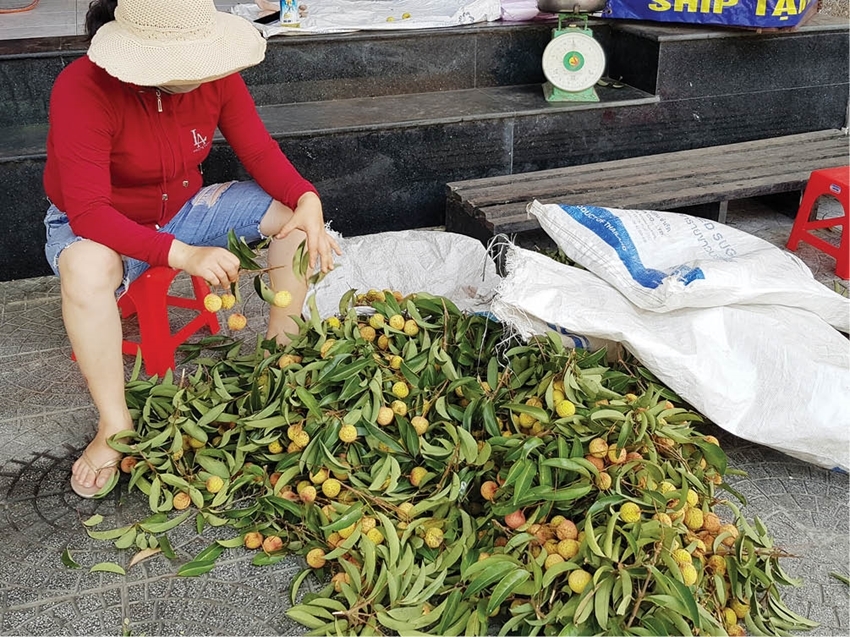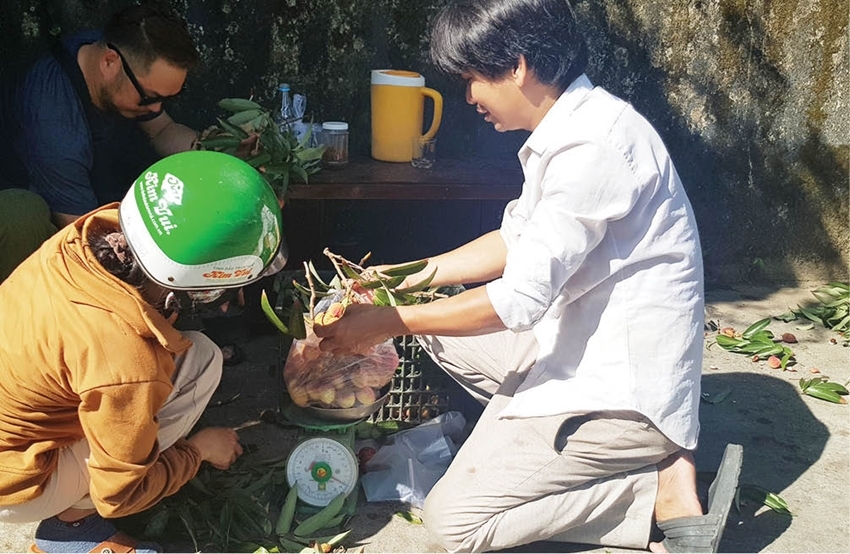   ');this.closest('table').remove();"> ');this.closest('table').remove();"> |
 |
| 100-hundred-year lichee trees add beauty to the Imperial City on sunny days. |
The nearly-130-year-old lichee tree at Phu My Hoa Congin Phan Chu Trinh Street is regarded as the oldest in Hue.
“I was told that my ancestor had been granted the precious fruit and this lichee tree is from those lichees. Previously there were three trees but two of them later snapped due to diseases and storms leaving only one left right at the gate. It gives fruit every year. The fruit is given the name hac le chibecause it has thick juicy flesh with a core inside as black as a crying eye,” said Dinh Phuoc belonging to the 9th generation.
The lichees grown at Phu My Hoa Congare oval in shape and scarlet in color. Every year from May onwards, viewed from An Cuu River, the whole tree glows with dangling red fruit attracting attention of people passing by.
   ');this.closest('table').remove();"> ');this.closest('table').remove();"> |
 |
| Harvesting lichees from old trees |
This year, the lichee tree gives around 200 kilograms of fruit. Many merchants offered to buy them all, but the owner wanted to save the fruit for worship and for his relatives and friends.
Many people in Hue know the nearly-200-year-old lichee tree at Princess An Thuong’s Residence, located on Nguyen Cong Tru Street - Emperor Ming Mang’s 4th daughter. The lichees there are oval in shape, scarlet in color and extremely fragrant. On the princess’s death anniversaries her descendants offer lichees to her. Those lichees are considered what she left for her descendants.
Most of the lichee trees left in Hue are old and from lichees granted by the kings. Many trees in the Citadel, Kim Long, Vy Da, etc., are more or less than 100 years old. However, as they are intended to give shade in gardens with a variety of trees and plants, they are not very well tended. As a consequence, they do not bear fruit regularly.
   ');this.closest('table').remove();"> ');this.closest('table').remove();"> |
 |
| Sorting lichees collected from garden houses in Hue |
The 65-year-old man Le Thanh Dan is of little build, but extremely quick. He has been working with his father as fruit pickers for about 50 years. They earn up to one million dongs a day by picking lichees for people. Without any tools he skillfully moves from this branch to another picking fruit, dropping them into the basket, then lowering the basket to his assistants on the ground, who tie the lichees into bunches. According to Dan, delicious lichees and longans can be found at old houses in Hue.
“The lichee trees give good fruit as they were well selected and because of the weather in Hue. They are as delicious as those grown in the North, where they come from,” said Dan.
Lichees in Hue are sold up to the price of 30,000-50,000dongs/kg, but their demand is always high because of their good quality. Many people buy lichees as rare gifts from the ancient capital for their relatives and friends in other regions.
“Lichees grown in Hue are special because they never get rotted at the head because of worms. Most of the lichee trees in Hue are old. They give sweet fruit with very thin peel and tiny cores, or even without cores. Though they are sold at a higher price than those from other areas, many people still buy them because they are delicious and literally “clean,” said Duong Van Loi, another lichee and longan picker.
Lichees reminding people of their ancestors
As recorded in historical documents, during the Nguyen era, the best lichees were presented to the Court every year. The kings then granted 3 lichees to those who had just passed exams as special favors. Many lichee trees were from those lichees which were named vai trang. Trangmeans the person who passes an exam. According to researchers, some lichees served as offerings at temples and royal mausoleums and some were given to mandarins.
   ');this.closest('table').remove();"> ');this.closest('table').remove();"> |
 |
| Sorting lichees |
Basing on Le Chi di tu ky su, experts at Landscape and Environment Bureau and Hue Monuments Conservation Center conclude that the lichee trees in the Imperial City are around 200 years old. Their fruit get ripe and ready for harvesting from May to August according to lunar calendar.
In Ming Mang’s era, the lichee was first grown in palaces then spread to gardens outside. In 1840 the king summoned princes and mandarins to Thieu Phuong Royal Garden, treated them to lichees and tea, composed a poem, then delivered it to the guests to mark the meeting event. They then brought the lichees home to grow.
In the Imperial City, there are about 120 lichee trees at The Mieu, Cung Dien Tho, Cung Truong Sanh, and so on. In summer, the ripe lichees add beauty to the golden palaces. According to those who have worked in the Imperial City for a long time, some of the trees give very good fruit with very small cores inside, as small as a green bean. People are very happy to taste them.
When lichees ripen, twittering birds summon. Those visitors who had a chance to taste the lichees all gave good compliments. They wish the lichees grown in the Imperial City to become a brand name as what happened with tea and wine so that many people can enjoy lichees as favors by the kings in the old days.
According to a culture researcher, lichees can be made into limited gifts completed with QR codes which contain information about the Imperial City so that visitors can buy them. Lichees should also be a gift on cultural exchange occasions showing off the precious fruit that is still preserved and developed. That is a good way to promote produce related to the Hue heritage.
The lichee is among the nine precious fruits which were embossed on the Nine Dynastic Urns. As described by ancient people, the lichee cover is like red silk; its peel is as thin as purple silk; its flesh is as white as snow, and its juice is both sweet and sour like fermented sticky rice. After being picked, it changes its color after one day; its fragrance changes after two days; and its taste changes after three days.
If you happen to be in the Imperial City in this season, you will see lines of lichee trees laden with fruit in the summer sun, and you can take good photos with them. Everyone wants to enjoy the well-known lichee, at least once.